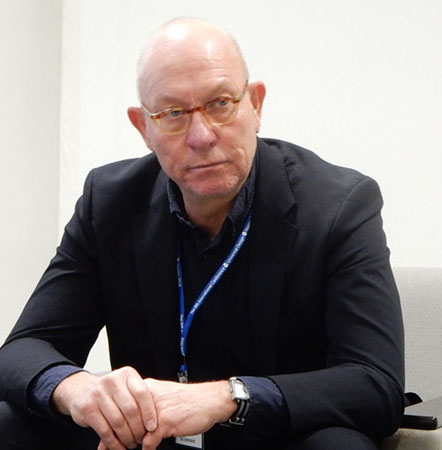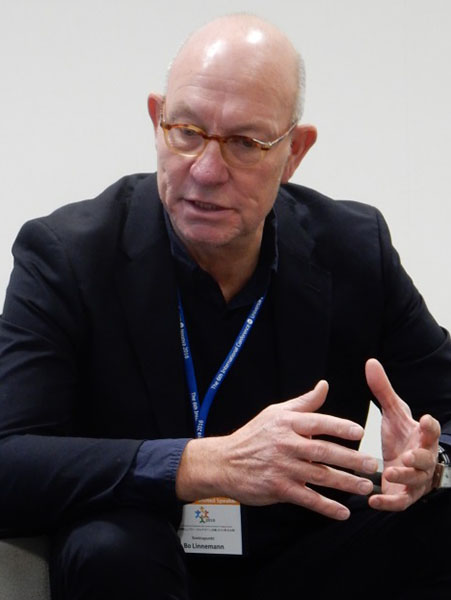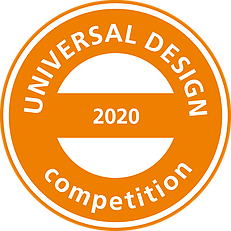2017.06.22
[Global Interview 2016] If highly accessible signs and information are offered, foreigners will feel accepted and can spend their time comfortably in Japan.
2017.06.20 Updated

Bo Linnemann
Creative Director, Architect, Owner and Co-Founder of Bo Linnemann and Kontrapunkt A/S Copenhagen and Tokyo, Denmark
Interviewer: Kazuaki Kitamura (Information Exchange Center / Okamura Corporation)
Interview date: Dec. 10, 2016 PM 12:00-
—Thank you for taking time out of your busy schedule for us today.
Bo Linnemann: It’s my pleasure. I am honored to be invited to this event.
—Mr. Linnemann have been taught at Musashino Art University, so you know well about Japan. What is your impression about universal design (UD) in Japan?
Bo Linnemann: Compared to Europe, Japan clearly defines UD and takes in-depth action that has yet to be initiated by Europe.
—When you teach students, how do you think Japanese students understand UD?
Bo Linnemann: Before talking about my students, let me tell you about my thought about UD as a designer. I think that UD is a concept and approach regarding design itself.
Specifically, if design is narrowed down for a limited number of people, it will benefit more people. If this UD concept is implemented in all design development, I think that better results will be produced as a whole. UD is to make people’s lifestyles easier (simpler) and remove barriers. This means that UD aims to remove barriers between technology and people and provide more accessibility and barrier-free design to public places. So understanding how design affects people’s thoughts and behavior forms the basis of UD. At Japanese schools (in particular, design schools), an understanding of UD is advanced. Japanese students spend more time in thinking about UD than overseas students. I visited a design school in Nagoya yesterday to observe a class, where a teacher was giving a lecture to students about how we can contribute to the entire society and how we were able to have that idea.
—You have participated in this conference. What was your impression about it?
Bo Linnemann: I don’t have an image of the entire Nagoya, but the speech I have just listened to was excellent. It is also great that experts from various countries of the world were gathered here to share knowledge. I am very honored to be given this opportunity to participate in this conference.
—I am told that you are engaged in airport design, etc. What do you think about the progress of UD at Japanese airports? And we have the 2020 Tokyo Olympics and Paralympics. Do you have any advice or suggestions about airport facilities, towns, and others?

Bo Linnemann: That is a good question, but difficult to answer. I live in Japan and see many things in Japan humbly. I think Japan is great. So I don’t have any specific advice. Specifically regarding the functions of infrastructure and public facilities, I think Japan is leading the world.
In Japan, when we travel, we are rarely faced with problems, traffic jams, so many people or other inconvenience, and everything goes smoothly. In particular, I have the impression that logistics and public transportation systems are working smoothly. I also highly recognize accessibility.
But if I were asked to give a suggestion, it would be that in addition to function, Japan can improve aesthetic appearance to make goods more appealing to people. Japan is very good at solving problems to make progress (being excellent in terms of function). I am from Denmark so emphasize not only function but also esthetic appearance.
Additionally, Leonard’s design is friendly to people in all aspects, is aesthetic, and has something appealing to emotions. But Japanese design is very functional but not emotionally compelling.
—As for aesthetic appearance, I think that designers need to work harder to enhance UD function, styling, and others.
We also attach importance to psychological support (hospitality) related to design in Japan. So we will encourage people to provide explanations and other assistance to foreigners. The International Association for Universal Design (IAUD) will also further promote psychological UD toward the year 2020. In closing, can you tell us about your opinions about or expectations for IAUD if any, because many private companies are also members of IAUD.
Bo Linnemann: As a communication designer, I think that communication in multiple languages is important. Particularly, when foreigners (non-Japanese people) come here, I think that it is essential to communicate messages by explaining directions and instructions as simply as possible. So it is necessary to use non-Japanese languages to clearly send messages to foreigners. Specifically, as a communication designer, I want to use typography to provide support for smooth communication.
Toward the year 2020, a lot of people will be visiting many places. When I walk around different towns in Tokyo, I see information posted in both Japanese and English. I feel something different about it. I think it is better to use something to let people get the same information visually, such as pictogram, etc.
In addition, the locations of signs. Information is too much in Japan. Directional signs exist here and there. In particular, signs are confusing at stations. Signs should be located in plain view. This is universal design, isn’t it?
The importance of communication should not be underestimated. If foreigners don’t understand messages in public places and directional information, they will feel isolated and out of place. In this regard, if highly accessible signs and information are offered, I think they feel accepted and can spend their time comfortably in Japan.
—I heard that Japan is trying to address the improvement of signs. I hope that your suggestion will be materialized. Thank you very much for your time today.
Inquiries
Please make your inquiry here (you will be automatically transferred to the Inquiries page).






![[Global Interview 2016] It would be very appreciated if Japan or IAUD could provide and share information and strategies to Europe. 画像](https://www.iaud.net/file/en/sites/3/03bade-1-320x289.jpg)
![[Global Interview 2016] It will be wonderful if the first-ever united Games of the Olympics for non-handicapped people and the Paralympics for handicapped people is realized in Japan in 2020. 画像](https://www.iaud.net/file/en/sites/3/04balaram-1-320x172.jpg)
![[Global Interview 2016] It will be great if the year 2020 becomes a good opportunity for the whole society to raise awareness of design, thereby changing the society for the better. 画像](https://www.iaud.net/file/en/sites/3/01wessler-1-320x279.jpg)
